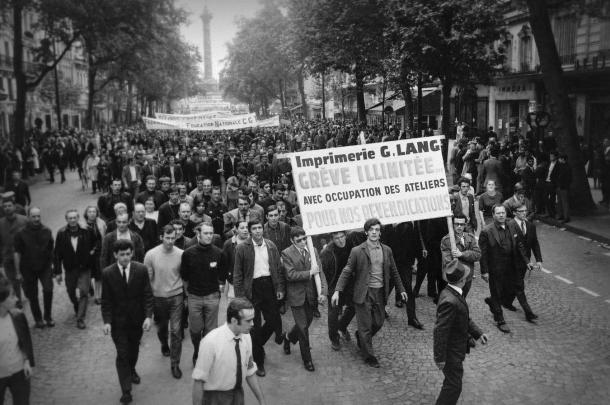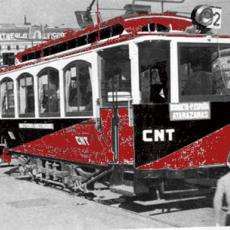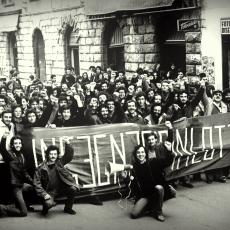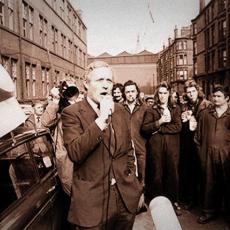A Factory Occupation in May 1968
Now that everything is back to “normal,” it may not seem very interesting to recall the very different sort of normality that briefly prevailed at the end of last spring. Moreover, what happened at this particular factory (Jeumont-Schneider) was not all that different from what was happening elsewhere, which everyone is already familiar with. Nevertheless, looking into the tarnished mirror of the past may help us to better understand ourselves.
On the afternoon of Friday, May 17, there were rumors in the workshops that the labor unions were cooking something up to deal with the rising wave. But over the weekend nothing happened.
Monday morning, the workers walked down the street, which was decorated with red flags, and gathered in front of the gates, not knowing whether they were supposed to go in or stay outside. They waited for an order. The union representative gave it: “Go on in, we’ll decide what needs to be done.” As usual the heavy iron gates closed again after everyone, like robots, had clocked in. But in the nearby Sifa antibiotics factory something had already happened. The red flag waved over their iron gates, which were sealed with handwritten white posters calling for a strike of indefinite duration, for things to change, for work to be transformed into a part of life rather than the destruction of life. . . .
“Something’s going to happen here, soon,” I was alerted by a young friend in the CFDT.*
And in fact in the workshops everyone had practically stopped working, with some showing impatience as they waited for that “something” to happen. At about nine o’clock the union representatives went around with a duplicated questionnaire to be filled in: “Are you for or against the following demands: minimum wage of 800 francs, 40-hour week without wage reductions, retirement at 60, repeal of the Social Security regulations, company recognition of labor-union rights? Are you for or against a general assembly of all the workers?” What responsibility were we going to have to take on, we the perennial signers of petitions, demands, requests, all destined for the wastebaskets?
At ten o’clock the workshops emptied and we gathered in the packing workshop. There were about 500 of us, mostly blue-collar workers, but also, this time, the foremen and a few white-collar workers. Over the years this particular workshop had been used for routine union-called meetings lasting half an hour or an hour, but there had never been nearly as many participants as this Monday morning (May 20). But routine had not ceased to rule — the same people managed the game and the rest only played along.
The union representatives were on the platform and the crowd, as usual, was almost totally silent. The first to speak was a CFDT representative, a middle-aged lathe operator with deep, shining eyes and a determined, passionate air. He praised the students’ courage and said that it was time for the workers to enter the struggle, so as to “open the eyes of the employers and the government, who have for ages refused to negotiate with the unions.” Shyly, a small red flag was unfurled and then raised behind the group of speakers. “I am not a Communist,” he said, “but I am for the red flag.” Then he recalled how the emblem had originated: during the barricades of 1848 someone had picked up a shirt steeped in a worker’s blood. This had served as a flag, and the shirt is said to be still preserved in a museum in Moscow. Even so, this red flag was a bit startling. In the past, collections for striking coal-miners or for Vietnam had always been conducted with the national tricolor flag. It was spread out at the factory exit and everybody showed their “active solidarity” by casting their contribution onto this sacred rag of the fatherland. But in fact we would have looked pretty lame to those students on the barricades, with their red flags and black flags, if we had brought out nothing but the old blue-white-red.
After the CFDT representative, the one from the CGT* confessed that he didn’t have much to add, and proposed to support the demands put forward by the unions by launching a strike of indefinite duration plus occupation of the factory. The younger workers seemed eager for action, while the older ones appeared cautious. The decision was taken by ballot. Everyone wrote their yes or no on a little piece of paper. The result was two-thirds for the strike, one-third against, with about twenty voting for a strike without an occupation.
With a tone of official authority, the CGT representative declared: “We call on you to put away your tools and leave the benches clean.”
The everyday routine was broken. Everyone was shaken and to a greater or lesser degree jolted out of their apathy. The problem was posed, and each saw it in their own way.
“Now we have to discuss what we’re going to do,” said G., a foreman. “Some of you want to overthrow the government. But if we do that, we need to know where we go from there. Tomorrow there will be no more milk for the babies . . .”
After lunch we gathered in the lunch room and elected a strike committee. Most of the candidates put forward for approval by our assembly were union representatives or other members of the CGT or CFDT, but a few unaffiliated young workers were also allowed in. A strike picket of forty volunteers was set up to ensure that the factory stayed occupied day and night. The committee invited everyone to come every day to take part in the factory occupation; but in reality this was just to protect the access to the factory, since only the strike picketers were allowed to freely move about inside the workshops. “Why do we need to occupy the factory? So that the boss doesn’t lock us out. Because once before he played that dirty trick on us, and then called back one by one only those workers he was willing to take on again.” The younger members of the committee were given the job of “organizing” our “leisure activities,” so as to counteract the boredom that would be suffered by the occupiers, a boredom that might be as unlimited as the strike itself.
Among the younger workers (a very small minority) a vague feeling developed that a profound change in our way of life was needed — one so profound that it would imply a change in the structures of society as a whole. To some of them who went to the Latin Quarter during the nights of the barricades, it seemed that the leaden lid of the Old World had been half-opened above our heads and that the time had come to blow it completely off. But the majority experienced the events passively, as though letting themselves be carried a little way into the unknown by the wave. Those over fifty had experienced the strike movement of 1936, and thus had no illusions: they remembered that the union bureaucrats had “known how to end a strike.”*
During the first week many of us came to the factory, and meetings organized by the strike committee for information and discussion took place frequently.
After the Grenelle Accords,* the CGT and CFDT showed less enthusiasm for strike committee meetings and general assemblies, using the inter-union meetings that were held nearly every day as the excuse for calling the larger meetings as infrequently as possible. Or else they briskly hurried through the meetings of the strike committee, with talk only about the lunch room or the nighttime guard, and nothing more.
On Tuesday, May 21, the young workers suggested that discussion groups be formed in order to consider our demands and other problems. After the assembly meeting, about thirty workers who liked this idea gathered in the conference room (which in normal times was open only to the managerial staff). A very good discussion developed about our demands, and about their contradictions and inadequacies. This led to the question of the relation between labor unions and political parties, but the discussion was brought to a sudden halt when the CGT representatives intervened, speaking aggressively and interrupting everyone.
On the first day of the strike the red flag flew alone over the factory gate, which was sealed with a big red poster expressing our demands. From the next day on, however, the tricolor was also there, side by side with the red flag. We later realized what this meant when the Communist Party proclaimed itself a party of order, “the first to denounce the sects of extremists and provocateurs,” and declared that it had been able to unite “the flag of the French Revolution” with “the flag of the working class.” Monsieur Waldeck-Rochet was really going too far. The flag of the Communards should not be associated with the flag of Versailles.* The tricolor is the flag of today’s bourgeoisie and bourgeois state. Since 1789 it has been under those colors that the bourgeoisie has exploited the workers and sent them to die on the field of honor; under those colors that it has enslaved the peoples of Africa and Asia.
In reality, of course, our CGT comrades were the Communist Party’s cell in the factory, just as Comrade Séguy, the leader of the CGT, was also a member of the Communist Party’s Political Bureau.
In the assemblies the workers said little, expressing themselves with difficulty. I will mention at random a few things that I recall. Someone proposed that we discuss the demands we had formulated, reminding us that we had already supposedly won the 40-hour week in 1936, yet since then we had continued to work between 48 and 56 hours. And now here we were, thirty-two years later, back at the same point.
“In those thirty-two years technology has evolved and production has increased,” said an old worker. “Why demand 40 hours and not 35?” In any case, even if tomorrow the bosses and the government were to agree to 40 hours, what would prevent them from double-crossing us just like they did before? Retirement at 60 would enable the older workers to enjoy some rest and the young to find work. This proposal did not arouse much interest among those present, and the committee closed the debate when it had scarcely begun.
Later, after Grenelle, there was no more talk in the strike committee about the 40-hour week or retirement at 60, only about a gradual reduction of working hours and lowering of the age of retirement.
Some comrades spoke of unity in struggle between the universities and the factories, and proposed that we invite the students of the UNEF and of the March 22nd Movement* to come to our factory and tell us about their actions. When the strike committee rejected this, they asked for their proposal to be put to a vote in the general assembly, but this proposal was ignored. Although a certain number of comrades favored the idea, nobody insisted. The representatives and younger members of the CFDT were in favor of such communication between workers and students, but they did not want to oppose the CGT representatives, for fear of “breaking unity of action.”
A group of young workers went to the “Communist” town hall of Saint-Denis seeking a venue outside the factory where they would be able to meet and talk with the students. At first they met with refusal, on the pretext that there were some suspicious elements in the Jeumont-Schneider factory. But then, to satisfy these young workers, a CGT representative intervened and they were given a room at 120 Avenue Wilson, a few hundred meters from the factory. The intended meeting did not take place, however, because the UNEF students did not show up.
* * *
On the day of the demonstration at the Saint-Lazare railroad station, which was organized by the CGT in favor of a democratic government that would include Communist ministers, at the general assembly the strike committee, or rather the CGT representatives, invited those present to take part in that demonstration in order to “support the negotiations between the bosses and the metalworkers’ union.” “You are trying to politicize the strike,” somebody responded. “Who do you think you’re kidding? The demonstration is aimed at supporting your policy, Séguy said so last night on television, and you’re trying to make us believe it’s only to support our demands.” Then the CFDT representative proposed supporting a government headed by Mendès-France.
At about one o’clock, four or five young men and women from the March 22nd Movement showed up outside the factory and tried to engage in conversation with the strikers. The CGT representatives intervened at once. One of them challenged the intruders: “What do you want? What is your program?” “Madame, we are not a political party, we don’t want to take power and we have no program. We just want to make contact in order to learn what is going on.”
In the discussion with the workers, one of the young men mentioned Séguy disdainfully. An enraged CGT representative sprang to grab him by the throat, as though he had blasphemed. One of the women workers, indignant at this representative’s fanaticism, broke in: “You have no right to stop him talking. Let him talk. I belong to the CGT, too, but everybody should be allowed to speak. Even the Trotskyists who came to hand out leaflets. You have no right to bully them.” Then she went on: “We can win improvements. Why make a revolution? Why cause bloodshed?”
Little by little, people began to speak out, especially outside the general assemblies and during the nighttime pickets. As a workmate put it, “If nothing else, this strike will at least have served to get the workers talking.” We discussed the events, the students, fascism, and all sorts of other issues. Some went in the evening to the Sorbonne, the Odéon or the École des Beaux-Arts, and when they returned the next day they brought back the ideas and the liberating atmosphere of those scenes.
Very often, in reaction against the farcical bread-and-butter demands presented at Grenelle, the idea of workers’ self-management was brought up. Responses were not hostile, but the workers generally thought themselves incapable of carrying out such a task effectively. They felt that this was a worldwide problem, something that could not be carried out within an individual factory, or even within a single country. They also sensed that the labor unions were not in favor of putting an end to the existing social order.
The entertainment committee invited some Portuguese musicians to come and perform fado songs. On May 21, when they arrived at the gate of the factory, these Portuguese friends contrasted the breadth and depth of the movement with the paltry content of our factory’s demands, and this had the effect of arousing the distrust of one of the CGT representatives. After the songs were over, a CFDT representative asked the performers, “Why are you on strike, and what are your demands?”
One of them answered: “Capitalist society exploits us through the impresarios, the record companies and the radio, just as it exploits the workers through the bosses. We are not demanding a 40-hour week (which we were supposed to have had since 1936) nor a minimum wage of 800 francs (because one needs more than 800 francs to live decently) — and in any case, why 800 francs here, 600 francs there, and 1000 francs somewhere else? We are also striking out of solidarity with the workers and the students. We are going into the factories to start a dialogue between workers and artists, which helps us to see more clearly that we all have the same problem: challenging the existing social system.” He concluded by saying that we must not let ourselves be hoodwinked.
This latter remark produced a violent reaction from the CGT representative: “You are here to sing, so sing! As for the workers, they are our concern.” The dialogue continued nevertheless, but soon these friends were asked to leave the factory and were ushered out by the union guards. Some of us left with them, and passed the rest of the afternoon with them in a café, away from the reactions of the union representatives.
Apart from a few such incidents, the union bureaucracy maintained its control in the factory. The tools were left intact; there was no smashing of machines by the students. No conflict, no hostile behavior of any sort by the young radicals or the older “anarchistic” workers. The manager was there every day, in his office. He signed for the release of funds for the lunch room, arranged advances of wages for the strikers, had occasional talks with the union representatives, and took no decision on his own. He, too, was waiting and following instructions.
An important event: the engineers came out on strike. On the first day, they held their meetings separately. Four days had to pass before, by a small majority, they decided on a solidarity strike. They held out for three weeks, meeting every day to discuss and work out their own statement of demands. Then they called for a secret ballot of the entire workforce, for or against going back to work. The majority of the workers were opposed to secret voting, and the engineers went back to work. Since the factory was closed and guarded by the strike pickets, the engineers worked on sites outside it.
In the middle of the last week of the strike, the big boss agreed to talk with the union representatives. Events speeded up. At the general assembly of Thursday, June 13, the CGT representative said that we should recognize that we had no choice but to go back to work. He then proposed a secret ballot on this question. The following day we proceeded to vote on the issue. The polling booths were brought out, just as for the routine elections when we had to choose a factory committee or other workforce representatives. The majority of the workers were discouraged and thought that one week more or less would make no difference, considering that the other branches of industry were already back at work, the workers’ front had been broken, and the metalworkers were almost alone in continuing to fight.
The lunch room was full when the result was announced: 423 votes for going back to work, 135 for continuing the strike, 3 invalid votes. The meeting erupted. Those who wanted to “continue the struggle” were at least pleased to find that they were still so numerous.
The management and the union representatives hurried to bring the affair to a close. They proposed that work be resumed that very afternoon, and the management would generously pay wages for the whole day. On every side the workers called out: “Monday, Monday!” A clear majority seemed to reject the bargain offered. At 1:00 p.m. we witnessed an astonishing spectacle, which could only have happened because the bureaucrats were under such intense pressure. The entire leadership of the CGT and the CFDT appeared at the factory gates, which were wide open. Two union representatives carrying the flags, the red one and the tricolor, made their way into the factory, followed hesitantly by a minority of the workers. Once inside, they sang the “Internationale.”
Monday morning, everyone was present at work and things were “back to normal.”
* * *
P.S. On Wednesday, May 22, two days after the beginning of our strike, the unions announced their readiness to negotiate with the bosses and the government. At the news of the opening of talks with Pompidou, everyone thought that, given the paralysis the country was in and the constant insurrectionary agitation by the students (which had aroused the workers in the first place), there was a good chance that the bosses and the capitalist state would make significant concessions. The hopes of some went further still, imagining that they were going to surrender quickly and that we would probably resume work within a week.
However, as soon as the famous Grenelle Accords of May 26 had been announced, and Séguy and Company had been booed at the Renault works, everyone felt that they had been double-crossed and realized that the struggle would get harder. At the general assembly on Tuesday, after telling the strikers the terms of the agreement, the union representatives themselves, as though gripped by the general dissatisfaction, simply proposed a continuation of the strike.
The feeling that we had been swindled was strengthened when the government broke the movement by granting advantageous conditions to the key sectors (electricity, the subway, the railways, the postal service, etc.) and the unions celebrated this as a victory.





Comments
Post new comment